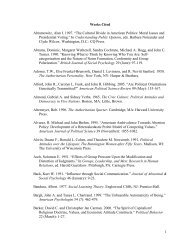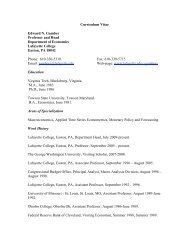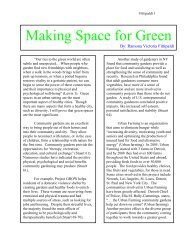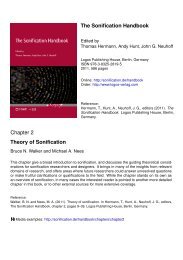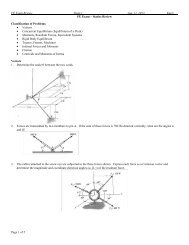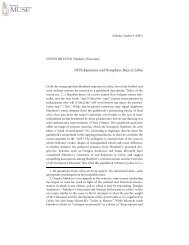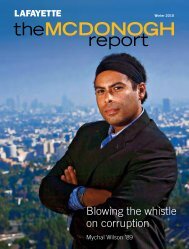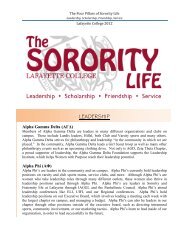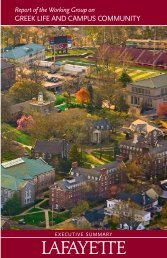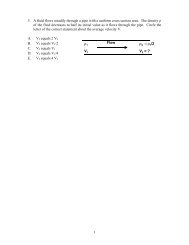Curbing Containment: Cold War Studies in the Twenty-First Century.
Curbing Containment: Cold War Studies in the Twenty-First Century.
Curbing Containment: Cold War Studies in the Twenty-First Century.
Create successful ePaper yourself
Turn your PDF publications into a flip-book with our unique Google optimized e-Paper software.
STEVEN BELLETTO<strong>Curb<strong>in</strong>g</strong> <strong>Conta<strong>in</strong>ment</strong>: <strong>Cold</strong> <strong>War</strong> <strong>Studies</strong> <strong>in</strong> <strong>the</strong><strong>Twenty</strong>-first <strong>Century</strong>David Castronovo, Beyond <strong>the</strong> Gray Flannel Suit: Books from <strong>the</strong> 1950s That MadeAmerican Culture. New York: Cont<strong>in</strong>uum, 2004. 207 pp. $22.95; $15.95 paper.Andrew Hoberek, The Twilight of <strong>the</strong> Middle Class: Post–World <strong>War</strong> II AmericanFiction and White-Collar Work. Pr<strong>in</strong>ceton, NJ: Pr<strong>in</strong>ceton UP, 2005. 158 pp. $19.95.Leerom Medovoi, Rebels: Youth and <strong>the</strong> <strong>Cold</strong> <strong>War</strong> Orig<strong>in</strong>s of Identity. Durham,NC: Duke UP, 2005. 387 pp. $23.95.Over <strong>the</strong> last decade, scholars of mid-century literatureand culture have produced significant bodies of workthat suggest <strong>the</strong> richness and complexity of <strong>the</strong> period.Flip missives like Marty Jezer’s The Dark Ages: Life <strong>in</strong><strong>the</strong> United States, 1945–1960 (1982) are be<strong>in</strong>g replaced by scholarshipas multifaceted as <strong>the</strong> period itself is com<strong>in</strong>g to be seen. Yes, conta<strong>in</strong>mentpolicy loomed and The Catcher <strong>in</strong> <strong>the</strong> Rye crowded paperbackracks, but contemporary work has challenged both <strong>the</strong> nostalgicviews Boomers tend toward and <strong>the</strong> critical rubrics that havebecome standard evaluative tools for many scholars. Three recentbooks promise to revise fur<strong>the</strong>r our understand<strong>in</strong>g of a periodvariously labeled “<strong>the</strong> cold war,” “post–World <strong>War</strong> II,” or “<strong>the</strong>1950s”: Leerom Medovoi’s Rebels: Youth and <strong>the</strong> <strong>Cold</strong> <strong>War</strong> Orig<strong>in</strong>s ofIdentity; Andrew Hoberek’s The Twilight of <strong>the</strong> Middle Class:Post–World <strong>War</strong> II American Fiction and White-Collar Work; and DavidCastronovo’s Beyond <strong>the</strong> Gray Flannel Suit: Books from <strong>the</strong> 1950s ThatMade American Culture. Taken toge<strong>the</strong>r, <strong>the</strong> subtitles of <strong>the</strong>se books<strong>in</strong>vite us to reconsider how <strong>the</strong> period is most profitably conceptu-Contemporary Literature XLVIII, 1 0010-7484; E-ISSN 1548-9949/07/0001-0150© 2007 by <strong>the</strong> Board of Regents of <strong>the</strong> University of Wiscons<strong>in</strong> System
B E L L E T T O • 151alized. For Medovoi, <strong>the</strong> unique pressures of cold war rhetorichelped shape <strong>the</strong> rise of identity and its s<strong>in</strong>gular expression—<strong>the</strong>rebel simultaneously scorned and championed by his (and her, heshows) culture. Hoberek shifts his <strong>in</strong>quiry from <strong>the</strong> cold war <strong>in</strong>favor of a read<strong>in</strong>g conscious of economic and class difference with<strong>in</strong><strong>the</strong> nation; hence <strong>the</strong> focus on post–World <strong>War</strong> II, a label that evokesnot conta<strong>in</strong>ment but material abundance, <strong>the</strong> postwar economicupturn that occasioned, Hoberek argues, a transformation of <strong>the</strong>American middle class that reverberates <strong>in</strong> mid-century writ<strong>in</strong>g.Castronovo, writ<strong>in</strong>g an old-fashioned celebration of fifties literaturethat hums along sans footnotes or works cited, is content to recover<strong>the</strong> 1950s as such with <strong>the</strong> aim of prov<strong>in</strong>g that <strong>the</strong> decade was not sostuffy as he supposes o<strong>the</strong>rs have supposed.The different labels adopted by <strong>the</strong>se scholars <strong>in</strong>dicate <strong>the</strong> vigorwith which cold war studies (as I like to call it) is be<strong>in</strong>g met. In additionto <strong>the</strong> books under review here, students of cold war culturecan pick up volumes as various as Christ<strong>in</strong>a Kle<strong>in</strong>’s <strong>Cold</strong> <strong>War</strong>Orientalism: Asia <strong>in</strong> <strong>the</strong> Middlebrow Imag<strong>in</strong>ation, 1945–1961 (2003),David Seed’s Bra<strong>in</strong>wash<strong>in</strong>g: The Fictions of M<strong>in</strong>d Control (2004), BruceMcConachie’s American Theater <strong>in</strong> <strong>the</strong> Culture of <strong>the</strong> <strong>Cold</strong> <strong>War</strong>:Produc<strong>in</strong>g and Contest<strong>in</strong>g <strong>Conta<strong>in</strong>ment</strong>, 1947–1962 (2003), and DavidK. Johnson’s The Lavender Scare: The <strong>Cold</strong> <strong>War</strong> Persecution of Gays andLesbians <strong>in</strong> <strong>the</strong> Federal Government (2004). Those <strong>in</strong>cl<strong>in</strong>ed to dateth<strong>in</strong>gs tend to credit <strong>the</strong> renewal of cold war studies to <strong>the</strong> culturalturn occasioned by <strong>the</strong> work of Donald Pease and o<strong>the</strong>rs <strong>in</strong> <strong>the</strong> mid-1980s. Pease’s classic essay “Moby-Dick and <strong>the</strong> <strong>Cold</strong> <strong>War</strong>” showedhow <strong>the</strong> favorite texts of <strong>the</strong> fifties liberal critical establishmentreflected <strong>the</strong> values of conta<strong>in</strong>ment America: after all, when it cameto totalitarian bromides and grim soliloquies, surely Ahab couldgive Stal<strong>in</strong> a run for his money. Lary May’s still-essential collectionRecast<strong>in</strong>g America: Culture and Politics <strong>in</strong> <strong>the</strong> Age of <strong>Cold</strong> <strong>War</strong> followed<strong>in</strong> 1989 and widened <strong>the</strong> range of cultural and literary <strong>in</strong>quiry. In1991, Thomas Schaub’s American Fiction <strong>in</strong> <strong>the</strong> <strong>Cold</strong> <strong>War</strong> expla<strong>in</strong>edhow and why American writers and critics moved from <strong>the</strong> radicalleft so devastated by Stal<strong>in</strong>ism to <strong>the</strong> more accommodat<strong>in</strong>g liberaldemocraticstatus quo that Arthur Schles<strong>in</strong>ger Jr. famously called“<strong>the</strong> Vital Center.” Schaub’s book was followed <strong>in</strong> 1995 by AlanNadel’s enormously <strong>in</strong>fluential <strong>Conta<strong>in</strong>ment</strong> Culture, which so
152 • C O N T E M P O R A R Y L I T E R A T U R Epowerfully demonstrated <strong>the</strong> pervasiveness of <strong>the</strong> “conta<strong>in</strong>mentnarrative”—<strong>the</strong> cultural extension of America’s foreign policy ofconta<strong>in</strong>ment—that even Disney’s Lady and <strong>the</strong> Tramp could be seento exhibit “sexual conta<strong>in</strong>ment.” Nadel’s argument was so successfuland wide-rang<strong>in</strong>g that mid-century cultural studies seemed forevermarked by <strong>the</strong> long arm of conta<strong>in</strong>ment.But not all scholars have been content to let conta<strong>in</strong>ment stand as<strong>the</strong> controll<strong>in</strong>g metaphor of cold war life. As Hoberek compla<strong>in</strong>s <strong>in</strong> <strong>the</strong><strong>in</strong>troduction to a 2002 critical collection: “While <strong>the</strong> <strong>Cold</strong> <strong>War</strong> cultureframework has revolutionized <strong>the</strong> way we talk about <strong>the</strong> 50s . . . itsdom<strong>in</strong>ance as a critical paradigm has produced a certa<strong>in</strong> bl<strong>in</strong>dness aswell. At its worst, it has become a rout<strong>in</strong>ized read<strong>in</strong>g generator: take a50s text that hasn’t been discussed yet, expla<strong>in</strong> how it reflects anambivalent liberalism hostile to political extremes (or designates somegroup as subversive, or denigrates <strong>the</strong> radical legacy of <strong>the</strong> 30s), andpublish.” 1 Nikita Khrushchev once removed his shoe and thumped it<strong>in</strong> frustration before <strong>the</strong> United Nations General Assembly; Hoberek’spo<strong>in</strong>t could be no more emphatic had he followed suit: for forwardth<strong>in</strong>k<strong>in</strong>gcold war scholars, <strong>the</strong> conta<strong>in</strong>ment model has run its course.In addition to Hoberek’s M<strong>in</strong>nesota Review collection, Fifties Culture, atleast four o<strong>the</strong>r collections have argued for an understand<strong>in</strong>g of midcenturyliterature and culture that isn’t predicated on what Hoberekcalls conta<strong>in</strong>ment’s “omnipresence and <strong>in</strong>evitability”: Reth<strong>in</strong>k<strong>in</strong>g <strong>Cold</strong><strong>War</strong> Culture, edited by Peter J. Kuznick and James Gilbert (2001); a“fifties fiction” special issue of Paradoxa edited by Joshua Luk<strong>in</strong> (2003);Gender and Culture <strong>in</strong> <strong>the</strong> 1950s, a special issue of Women’s <strong>Studies</strong>Quarterly edited by Deborah Nelson (2005); and <strong>Cold</strong> <strong>War</strong> Literature:Writ<strong>in</strong>g <strong>the</strong> Global Conflict, edited by Andrew Hammond (2006).Medovoi’s and Hoberek’s books are important <strong>in</strong>terventions <strong>in</strong> thisteem<strong>in</strong>g critical field: without rely<strong>in</strong>g on <strong>the</strong> explanatory power of <strong>the</strong>conta<strong>in</strong>ment model, <strong>the</strong>se studies none<strong>the</strong>less assume a complex relationshipbetween literature and culture that will cont<strong>in</strong>ue to re<strong>in</strong>vigorate<strong>the</strong> cold war cultural studies paradigm.Leerom Medovoi’s Rebels is a hefty contribution to our evolv<strong>in</strong>gunderstand<strong>in</strong>g of mid-century culture. Sensible, focused, and rife1. Andrew Hoberek, “<strong>Cold</strong> <strong>War</strong> Culture to Fifties Culture,” M<strong>in</strong>nesota Review 55–57(2002): 146.
B E L L E T T O • 153with unexpected juxtapositions, <strong>the</strong> book unfolds through nuancedargument and search<strong>in</strong>g scholarship. Medovoi moves cold war studies<strong>in</strong> new directions by exam<strong>in</strong><strong>in</strong>g <strong>the</strong> rise of identity as a conceptafter World <strong>War</strong> II and <strong>the</strong>n by show<strong>in</strong>g how <strong>the</strong> identification of“rebel” was l<strong>in</strong>ked to national allegories about democratic freedom.The connection Medovoi posits between <strong>the</strong> private and <strong>the</strong> public—<strong>the</strong> local and <strong>the</strong> global—depends on a particular def<strong>in</strong>ition ofidentity that <strong>the</strong> rebel animates: “[T]he politics of identity demandthat <strong>the</strong> sovereignty of <strong>the</strong> people rema<strong>in</strong> commensurate with <strong>the</strong>self-determ<strong>in</strong>ation of its <strong>in</strong>dividual members. The collectivity o<strong>the</strong>rwisebecomes a totalitarian mass, formed through a coerced equivalenceof its members that denies <strong>the</strong>m identity precisely by robb<strong>in</strong>g<strong>the</strong>m of <strong>the</strong>ir right to psychopolitical sovereignty” (55).In his first chapter, Medovoi expla<strong>in</strong>s <strong>the</strong> global stakes of <strong>the</strong>“psychopolitical sovereignty” that identity makes possible byurg<strong>in</strong>g scholars to view <strong>the</strong> cold war as an “age of three worlds.”Medovoi has advanced this argument before; as he writes <strong>in</strong> Rebels:“U.S.-Soviet rivalry . . . did not play out on a dichotomous globe <strong>in</strong> asimple scenario of ‘us aga<strong>in</strong>st <strong>the</strong>m,’ as a ‘conta<strong>in</strong>ment’ approach to<strong>Cold</strong> <strong>War</strong> culture implicitly presumes. Ra<strong>the</strong>r, it took <strong>the</strong> form of atriangulated rivalry over ano<strong>the</strong>r universe that only now becameknown as <strong>the</strong> ‘third world.’. . . By <strong>the</strong> mid-1950s, <strong>the</strong> ‘three worldsconcept’ had become <strong>the</strong> globe’s dom<strong>in</strong>ant topological imag<strong>in</strong>ary”(10–11). 2 To substantiate this claim, Medovoi describes howbetween 1945 and 1960, forty countries with populations total<strong>in</strong>gover eight hundred million “revolted aga<strong>in</strong>st colonialism” to create“newly sovereign ‘national characters’ “ (11). It was <strong>the</strong>se newnational characters that served as <strong>the</strong> most important proxies <strong>in</strong> <strong>the</strong>U.S.-Soviet rivalry. In <strong>the</strong> ideological battle for <strong>the</strong> third world, heargues, <strong>the</strong> United States’s own national character rose to paramountimportance and was l<strong>in</strong>ked on several levels to <strong>the</strong> rebel: notonly was America born of its own anticolonialist revolt, but it wasalso a young nation ripe with democratic possibility. Whatever itsspecific manifestation, <strong>the</strong> rebel functions for Medovoi as a signof self-determ<strong>in</strong>ation, an avatar of America’s “perennial spirit of2. See Leerom Medovoi, “<strong>Cold</strong> <strong>War</strong> American Culture as <strong>the</strong> Age of Three Worlds,”M<strong>in</strong>nesota Review 55–57 (2002): 167–86.
154 • C O N T E M P O R A R Y L I T E R A T U R E‘critical nonconformity’” (86) crucial to national self-image with<strong>in</strong><strong>the</strong> three-world imag<strong>in</strong>ary.The three-worlds <strong>the</strong>ory is a useful departure from <strong>the</strong> conta<strong>in</strong>mentmodel because it understands cold war culture as bothconsensus-m<strong>in</strong>ded and committed to <strong>in</strong>dividual determ<strong>in</strong>ation. Inexplor<strong>in</strong>g this duality, Medovoi moves away from avenues of<strong>in</strong>quiry familiar to cold war scholars—George Kennan’s LongTelegram and <strong>the</strong> foreign policy it <strong>in</strong>spired, for <strong>in</strong>stance—<strong>in</strong> orderto exam<strong>in</strong>e how a particular phase of capitalism helped shapeAmerican self-image. Read<strong>in</strong>g cold war America as a Fordist epochallows Medovoi to claim that consensus culture hadn’t quite gelled<strong>in</strong> <strong>the</strong> ways people suppose or remember: “[A] politically potentdiscursive formation began to emerge out of <strong>the</strong> gap between a <strong>Cold</strong><strong>War</strong> political imag<strong>in</strong>ary that envisioned <strong>the</strong> United States as democratic,self-determ<strong>in</strong><strong>in</strong>g, and agential, and a Fordist economic orderwhose system of mass consumer standardization posed a threaten<strong>in</strong>gcontrary national appearance. In effect, this discourse imag<strong>in</strong>ativelysplit America <strong>in</strong> two: <strong>the</strong> America of identity or rebellion, asrepresented by <strong>the</strong> subject of youth, and <strong>the</strong> America of conformity,as embodied <strong>in</strong> <strong>the</strong> object world of Fordist mass culture” (34–35).Medovoi’s identification of this imag<strong>in</strong>ative split casts cold warAmerica not as a Borg-like monolith but ra<strong>the</strong>r as a striated nationboth dynamic and conflicted. Such dynamism <strong>in</strong> turn po<strong>in</strong>ts to <strong>the</strong>appeal of <strong>the</strong> rebel and youth culture: “In all of its complexity, <strong>the</strong>teenager of postwar U.S. culture represented noth<strong>in</strong>g less than a figureof psychopolitical sovereignty, a <strong>Cold</strong> <strong>War</strong> <strong>in</strong>stantiation of [Erik]Erikson’s ‘freeborn American son’ as def<strong>in</strong>ed aga<strong>in</strong>st his anti<strong>the</strong>sis,<strong>the</strong> compliant youth of totalitarian society” (30).What is perhaps most excit<strong>in</strong>g about Medovoi’s <strong>the</strong>sis is that i<strong>the</strong>lps us understand how <strong>the</strong> fifties became <strong>the</strong> sixties. Describ<strong>in</strong>g<strong>the</strong> ultimate scope of his argument, he claims that by read<strong>in</strong>g <strong>the</strong>decade as “<strong>the</strong> <strong>in</strong>augural moment of identity” we might understandhow it gave birth to “new political potentialities” (49). The ideologyof <strong>the</strong> rebel represents an emergent category of “identity” that prefigured<strong>the</strong> rise of identity politics <strong>in</strong> <strong>the</strong> sixties, seventies, andbeyond. In its effort to trace <strong>the</strong> orig<strong>in</strong>s of <strong>the</strong> sixties <strong>in</strong> <strong>the</strong> fifties(ra<strong>the</strong>r than view<strong>in</strong>g <strong>the</strong> sixties as a reaction to <strong>the</strong> fifties), Rebelsrepresents not only a way to understand late twentieth-century cul-
B E L L E T T O • 155tural history but also a more complex way to understand <strong>the</strong> fiftiesas such.After establish<strong>in</strong>g <strong>the</strong> groundwork for his argument, Medovoioffers well-reasoned analyses of cultural materials rang<strong>in</strong>g fromChuck Berry standards to <strong>the</strong> novels and poetry of <strong>the</strong> Beats. By situat<strong>in</strong>gsuch phenomena <strong>in</strong> <strong>the</strong> cultural matrix that he articulates<strong>in</strong> his first two chapters, Medovoi at once <strong>in</strong>vites reexam<strong>in</strong>ationof seem<strong>in</strong>gly simple artifacts and deepens our understand<strong>in</strong>g ofpostwar life. A chapter titled “Rock ’n’ Roll and <strong>the</strong> SuburbanCounterimag<strong>in</strong>ary” is illustrative. While typical accounts of <strong>the</strong>postwar suburban boom often follow <strong>the</strong> argument made byWilliam Whyte <strong>in</strong> The Organization Man (1956) that postwar suburbancommunities functioned as a place of belong<strong>in</strong>g, Medovoi usesrock and roll to understand <strong>the</strong> suburbs as a stag<strong>in</strong>g ground forrebellion: “rock ’n’ roll allowed youth culture to constitute a Fordistcounterimag<strong>in</strong>ary, a way of see<strong>in</strong>g oneself as simultaneouslywith<strong>in</strong>, yet implicitly critical of, postwar suburbia” (94). With thisidea, Medovoi departs from <strong>the</strong> more widespread account of rockand roll that suggests that its early commodification made it ideologicallyparalyzed. Although Medovoi’s idea is <strong>in</strong>trigu<strong>in</strong>g, hesometimes assumes that rock-and-roll lyricists overloaded <strong>the</strong>ir riftswith ore (my favorite is his analysis of The Coasters’ hit “YaketyYak”: s<strong>in</strong>ce a square suburban dad could hardly be hip enough toknow “what cooks,” <strong>the</strong> song “allowed suburban teenagers to beimag<strong>in</strong>atively partnered with <strong>in</strong>ner-city youth as escapees fromparental mandates” [118]). In <strong>the</strong> end, one forgives Medovoi’s analyticalzeal because his conclusions are so well drawn and ultimatelyjustified by <strong>the</strong> material he has selected.From his analysis of rock and roll and <strong>the</strong> suburbs, Medovoiexam<strong>in</strong>es <strong>in</strong> detail <strong>the</strong> racial and gender politics of cold war rebellion.He devotes three chapters to adept read<strong>in</strong>gs of well-knownfilms (Blackboard Jungle, Rebel without a Cause, Imitation of Life, Gidget)and less frequently analyzed films (K<strong>in</strong>g Creole, starr<strong>in</strong>g ElvisPresley, and Girls Town, a 1959 version of Boys Town). Especiallyassured is his analysis of Blackboard Jungle, a film that began life as awarn<strong>in</strong>g about juvenile del<strong>in</strong>quency but ended up appeal<strong>in</strong>g toyouth culture as a “proto-teenpic.” Medovoi sees <strong>in</strong> <strong>the</strong> film both<strong>the</strong> imag<strong>in</strong>ative split mentioned earlier and <strong>the</strong> “generational rifts
156 • C O N T E M P O R A R Y L I T E R A T U R Eaccompany<strong>in</strong>g <strong>the</strong> rise of identity discourse” (164). Through a richanalysis of <strong>the</strong> scene <strong>in</strong> which Glenn Ford’s Mr. Dadier shows hisrowdy class a Jack and <strong>the</strong> Beanstalk cartoon, Medovoi ultimatelystakes a claim for Blackboard Jungle’s importance <strong>in</strong> <strong>the</strong> history ofidentity politics. He argues that <strong>the</strong> modes of rebellion <strong>the</strong> filmexplores grow <strong>in</strong> importance after <strong>the</strong> fifties (152) and become manifest<strong>in</strong> sem<strong>in</strong>al works like Eldridge Cleaver’s Soul on Ice. Leav<strong>in</strong>gBlackboard Jungle beh<strong>in</strong>d, Medovoi also offers solid read<strong>in</strong>gs of <strong>the</strong>“erotics of rebel identity” (188) <strong>in</strong> Rebel without a Cause, racial politics<strong>in</strong> K<strong>in</strong>g Creole and Imitation of Life, and <strong>the</strong> girl as rebel <strong>in</strong> Gidgetand Girls Town.Of particular <strong>in</strong>terest to students of literary history is Medovoi’ssuggestion that <strong>the</strong> identity of <strong>the</strong> Beat generation did not growspontaneously but ra<strong>the</strong>r was actively created. Supported by read<strong>in</strong>gsof Jack Kerouac’s On <strong>the</strong> Road, John Clellon Holmes’s Go, andAllen G<strong>in</strong>sberg’s “Howl,” Medovoi analyzes how <strong>the</strong> concept of <strong>the</strong>“Beat generation” can be traced to identity politics: “<strong>the</strong> story toldby <strong>the</strong> beat texts is not that of a generation as a fait accompli but, on<strong>the</strong> contrary, <strong>the</strong> difficult struggle to br<strong>in</strong>g one <strong>in</strong>to be<strong>in</strong>g, <strong>the</strong>embattled process of young people’s enlistment <strong>in</strong>to <strong>the</strong> beat generation,understood as <strong>the</strong> common identity project of <strong>the</strong>ir time”(224). As is <strong>the</strong> case throughout Rebels, Medovoi’s sensitivity to <strong>the</strong>gender politics submerged <strong>in</strong> <strong>the</strong> Beat aes<strong>the</strong>tic is acute; he notes,for example, that <strong>in</strong> On <strong>the</strong> Road, “A beat boy is a youthful angel whodescends on his young male friends and sweeps <strong>the</strong>m away from<strong>the</strong> trap of <strong>the</strong>ir married homes” (230). Thus Beat fraternity is l<strong>in</strong>kedto rebellion: pick<strong>in</strong>g up on Carole Pateman’s work <strong>in</strong> The SexualContract, Medovoi argues, “Pateman’s <strong>in</strong>sight that fraternity isimag<strong>in</strong>ed to orig<strong>in</strong>ate <strong>in</strong> <strong>the</strong> revolutionary struggle aga<strong>in</strong>st <strong>the</strong>fa<strong>the</strong>r . . . allows us to consider rebellion as <strong>the</strong> central drama of beatbro<strong>the</strong>rhood” (256).If <strong>the</strong> po<strong>in</strong>t that <strong>the</strong> Beats were rebellious seems self-evident, takeheart, for Medovoi explores <strong>in</strong> more detail <strong>the</strong> homosocial politics of<strong>the</strong> Beat generation, a welcome addition to <strong>the</strong> work of SuzanneClark, Robert Corber, and o<strong>the</strong>rs who have charted <strong>the</strong> socialvalences of homosexuality dur<strong>in</strong>g <strong>the</strong> period. And it is difficult toargue with his conclusion that <strong>the</strong> Beats “clung tenaciously to arigid code of gender value that valorized mascul<strong>in</strong>e agency while
B E L L E T T O • 157devalu<strong>in</strong>g passivity as a fem<strong>in</strong><strong>in</strong>e weakness” (260). Despite its focuson mascul<strong>in</strong>e agency, <strong>in</strong> <strong>the</strong> end, Medovoi’s analysis of Beat fraternitycould have benefited by <strong>in</strong>clud<strong>in</strong>g <strong>the</strong> women who witnessed<strong>the</strong> Beat boys writ<strong>in</strong>g to one ano<strong>the</strong>r. Although readers discover alone paragraph on Alix Kates Shulman’s Burn<strong>in</strong>g Questions and asentence on Joyce Johnson’s M<strong>in</strong>or Characters: A Beat Memoir, fans ofDiane di Prima’s Memoirs of a Beatnik or Carolyn Cassady’s Off <strong>the</strong>Road: My Years with Cassady, Kerouac, and G<strong>in</strong>sberg or Hettie Jones’sHow I Became Hettie Jones may want to know why Medovoi choosesnot to discuss <strong>the</strong>m, as <strong>the</strong>y all write on <strong>the</strong> very gendered myopiahe describes.Rebels is at heart a valuable work of cultural studies; as such, itsfocus is divided: it offers extended analyses of music and film whiledevot<strong>in</strong>g only two chapters—on J. D. Sal<strong>in</strong>ger and on <strong>the</strong> Beats—toliterature. It’s hard to call this a weakness because <strong>the</strong> book is excellentat what it sets out to do, but it may leave certa<strong>in</strong> members ofEnglish departments wonder<strong>in</strong>g how Medovoi’s claims play out <strong>in</strong>o<strong>the</strong>r works of fiction. Old-time Book-of-<strong>the</strong>-Month clubbers mayremember Lieutenant Maryk from Herman Wouk’s PulitzerPrize–w<strong>in</strong>n<strong>in</strong>g (and best-sell<strong>in</strong>g) The Ca<strong>in</strong>e Mut<strong>in</strong>y (1951): whenMaryk disobeys Capta<strong>in</strong> Queeg’s maniacal orders, <strong>the</strong>reby sav<strong>in</strong>g<strong>the</strong> ship from certa<strong>in</strong> destruction, was he figured as a rebel? Does itmatter that middlebrow Wouk, <strong>in</strong> contrast to <strong>the</strong> writers Medovoidiscusses, condemns Maryk’s dissent? Of course it is never fair toask a book to be someth<strong>in</strong>g it isn’t—Rebels is a masterful study of <strong>the</strong>texts and contexts it does engage—but Medovoi’s <strong>the</strong>sis is so<strong>in</strong>trigu<strong>in</strong>g that one wishes it could have been given fuller treatment<strong>in</strong> some o<strong>the</strong>r texts of <strong>the</strong> era.As Medovoi uses <strong>the</strong> rise of identity to broaden our sense of coldwar culture, Andrew Hoberek’s The Twilight of <strong>the</strong> Middle Classrereads canonical postwar texts through <strong>the</strong> lens of economics andclass. Even though Marxism <strong>in</strong> its various guises has had an <strong>in</strong>calculable<strong>in</strong>fluence on American studies, Hoberek is right to po<strong>in</strong>t outthat cold war scholars are apt to overlook questions of economicsand class <strong>in</strong> favor of o<strong>the</strong>r pursuits. He proves <strong>the</strong> fruitfulness ofturn<strong>in</strong>g to such a framework <strong>in</strong> his central read<strong>in</strong>gs of Ayn Rand’sAtlas Shrugged, Ralph Ellison’s Invisible Man, Saul Bellow’s TheAdventures of Augie March, and Flannery O’Connor’s Wise Blood and
158 • C O N T E M P O R A R Y L I T E R A T U R Eshort stories. As this selection may suggest, although Twilight fliesunder <strong>the</strong> banner of class studies, it is also a book about style; someof Hoberek’s f<strong>in</strong>est moments emerge as he reads <strong>the</strong> stylistic <strong>in</strong>novationsof <strong>the</strong>se works as responses to <strong>the</strong> nation’s chang<strong>in</strong>g senseof <strong>the</strong> middle class.Twilight’s pr<strong>in</strong>cipal argument is predicated on <strong>the</strong> idea that by <strong>the</strong>end of World <strong>War</strong> II <strong>the</strong> middle class could no longer look to propertyownership as a marker of self-def<strong>in</strong>ition. This broad change ledto <strong>the</strong> disaffected Professional-Managerial Class (PMC) described <strong>in</strong>contemporary works like The Organization Man and C. WrightMills’s White Collar (1951). Hoberek th<strong>in</strong>ks <strong>the</strong> PMC felt a loss ofpersonal agency when <strong>the</strong> middle class was no longer identifiedwith property ownership; he fur<strong>the</strong>r posits a structural similaritybetween <strong>the</strong> PMC and writers and o<strong>the</strong>r <strong>in</strong>tellectuals who performedmental labor. Hoberek suggests that <strong>in</strong> <strong>the</strong> postwar world,“<strong>in</strong>tellectual work was def<strong>in</strong>itively reconfigured as someth<strong>in</strong>g thattook place with<strong>in</strong> <strong>in</strong>stitutions” (21). Because of this reconfiguration,<strong>in</strong>tellectuals became <strong>in</strong> effect white-collar employees who could nolonger count on <strong>the</strong> antagonistic relationship to <strong>the</strong> middle classenjoyed by <strong>the</strong> Ezra Pounds of earlier generations. Understand<strong>in</strong>g<strong>in</strong>tellectuals as white-collar employees allows Hoberek to ascribe to<strong>the</strong>m <strong>the</strong> “typically white-collar sense of <strong>in</strong>stitutional disempowerment”(22) familiar to any middle manager <strong>in</strong> corporate America.Hoberek thus identifies <strong>the</strong> special condition of postwar <strong>in</strong>tellectualwork: seem<strong>in</strong>gly more autonomous than <strong>the</strong>ir counterparts at IBMor AT&T, writers and <strong>in</strong>tellectuals none<strong>the</strong>less found <strong>the</strong>mselvesoperat<strong>in</strong>g <strong>in</strong> <strong>the</strong> same economic sphere. To assert <strong>the</strong>ir <strong>in</strong>dividualagency, writers thus created “via style a preserve of autonomy thatwould dist<strong>in</strong>guish <strong>the</strong> artist from <strong>the</strong> organization man” (116).Hoberek’s first object lesson is Ayn Rand’s formidable AtlasShrugged, a novel that for him “allegorizes <strong>the</strong> transformation ofmiddle-class identity” (37). Rand’s fictionalized polemic operates assometh<strong>in</strong>g like an <strong>in</strong>version of <strong>the</strong> 2004 film A Day without aMexican: ra<strong>the</strong>r than imag<strong>in</strong><strong>in</strong>g what would happen if an economy’smost exploited workforce disappeared, Atlas Shrugged offers aworld <strong>in</strong> which highly visible capta<strong>in</strong>s of <strong>in</strong>dustry remove <strong>the</strong>mselvesfrom society. Rand’s heroes are <strong>in</strong>ventive company headswho have quit carry<strong>in</strong>g <strong>the</strong> underappreciative masses. Hoberek
B E L L E T T O • 159argues that Rand’s book is more <strong>in</strong> l<strong>in</strong>e with a fifties economic ethosthan we may have thought—not only because it conforms to <strong>the</strong>postwar celebration of frontier <strong>in</strong>dividualism, but also because itvalorizes mental labor. The market is for Rand “not <strong>the</strong> source ofsocial <strong>in</strong>equality but <strong>the</strong> mechanism for elim<strong>in</strong>at<strong>in</strong>g hierarchicalrelationships” (38). While Hoberek takes Rand to task for harbor<strong>in</strong>ga “flawed picture of post-war capitalism” (41) that ignores <strong>the</strong> complexitiesof power politics, he ultimately suggests that her appeallies <strong>in</strong> her depiction of a world where people have personal attachmentto <strong>the</strong>ir work and where <strong>the</strong>y are valued precisely for thiswork (46). Such wistfulness for a world dom<strong>in</strong>ated by highly idiosyncratic,highly respected mental work sounds like a rally<strong>in</strong>gcry for impecunious grad students and three-campus adjunctseverywhere, and <strong>in</strong> fact Hoberek closes this chapter by <strong>in</strong>sist<strong>in</strong>gthat Rand’s novel rem<strong>in</strong>ds us that contemporary academics havebecome white-collar mental laborers beholden to <strong>the</strong> “regime” (52).In his next chapter, Hoberek analyzes Ralph Ellison’s InvisibleMan <strong>in</strong> terms of “historically specific concerns about middle-classproletarianization and downward mobility” (54–55). By focus<strong>in</strong>g on<strong>the</strong> aspects of Invisible Man that look like o<strong>the</strong>r mid-century novelsof “white-collar angst” such as The Man <strong>in</strong> <strong>the</strong> Gray Flannel Suit orRand’s The Founta<strong>in</strong>head, Hoberek is able to show how <strong>the</strong> novelengages <strong>the</strong> “middle-class tendency to project onto all organizations<strong>the</strong> de<strong>in</strong>dividualiz<strong>in</strong>g white-collar workplace” (55). Such a read<strong>in</strong>ghardly accounts for Invisible Man’s considerable complexity, ofcourse, and Hoberek pushes our th<strong>in</strong>k<strong>in</strong>g about Ellison <strong>in</strong>to newterra<strong>in</strong>. Ra<strong>the</strong>r than assum<strong>in</strong>g that all varieties of angst and alienationare created equal, Ellison ma<strong>in</strong>ta<strong>in</strong>s dist<strong>in</strong>ctions amongvarious types of nonmanual work. Accord<strong>in</strong>g to Hoberek, “Thisallows Ellison to critique a compet<strong>in</strong>g—and ultimately much moresuccessful—discourse of race, exemplified by <strong>the</strong> work of figureslike Norman Mailer and Jack Kerouac, that sees idealized forms ofAfrican American au<strong>the</strong>nticity as <strong>the</strong> antidote to white middle-classalienation” (57). Thus Hoberek exposes <strong>the</strong> racial politics underp<strong>in</strong>n<strong>in</strong>gclassic organization-man discourse: Invisible Man complicates<strong>the</strong> “time-honored” notion that “<strong>the</strong> worst part of white-collar selfalienationis that it forces white people to do ‘black’ labor” (60).Unlike writers who lament <strong>the</strong> white-collar organization, Ellison
160 • C O N T E M P O R A R Y L I T E R A T U R Eoffers a more sophisticated understand<strong>in</strong>g of power, one critical of alogic that labels everyth<strong>in</strong>g <strong>in</strong>side <strong>the</strong> organization bad and everyth<strong>in</strong>goutside of it desirable (66).Identity politics take center stage <strong>in</strong> <strong>the</strong> next two chapters, “TheSo-Called Jewish Novel” and “Flannery O’Connor and <strong>the</strong> Sou<strong>the</strong>rnOrig<strong>in</strong>s of Identity Politics,” as Hoberek explores how Jewishness orSou<strong>the</strong>rnness might counter or critique “<strong>the</strong> contemporaneousemergence of <strong>the</strong> ‘generic, abstract cultural nonbe<strong>in</strong>g’ associatedwith <strong>the</strong> pathologized normalcy of <strong>the</strong> white-collar middle class”(70). Aga<strong>in</strong> return<strong>in</strong>g to <strong>the</strong> idea that style served as a way toexpress <strong>in</strong>dividualism or autonomy, Hoberek argues that forauthors like Bellow and Roth, “<strong>the</strong> figure of <strong>the</strong> Jewish <strong>in</strong>tellectualprovides <strong>the</strong> textual bridge between <strong>the</strong> world of white-collar worktransform<strong>in</strong>g Jews <strong>in</strong>to generic members of <strong>the</strong> middle class and <strong>the</strong>formal <strong>in</strong>novations that enable Jewish American fiction to exemplifyan appeal<strong>in</strong>g ethnic difference” (71). Likewise, Hoberek th<strong>in</strong>ksthat O’Connor’s Wise Blood “abandons physical property as a sourceof middle-class <strong>in</strong>dividualism [and] . . . circuitously regrounds such<strong>in</strong>dividualism <strong>in</strong> <strong>the</strong> <strong>in</strong>tangible property of cultural identity” (95).Although, as Hoberek notes, O’Connor disliked mass-cult visions of<strong>the</strong> South (th<strong>in</strong>k The Andy Griffith Show), she none<strong>the</strong>less “participateswith <strong>the</strong>m <strong>in</strong> <strong>the</strong> project of imag<strong>in</strong><strong>in</strong>g regional alternatives to<strong>the</strong> de<strong>in</strong>dividualiz<strong>in</strong>g organization” (100). Hoberek analyzes WiseBlood and two of her best-known stories, “The Artificial Nigger”and “A Good Man Is Hard to F<strong>in</strong>d,” with <strong>the</strong> aim of show<strong>in</strong>g howO’Connor’s profoundly disenfranchised characters challenge <strong>the</strong>broader cultural tendencies of organization-man discourse.For all of Hoberek’s examples of <strong>the</strong> ambivalence <strong>in</strong>tellectualsheld toward an organizational culture that figured <strong>the</strong>m as mentallaborers, he surpris<strong>in</strong>gly doesn’t explore <strong>in</strong> more depth <strong>the</strong> notionthat <strong>in</strong>tellectuals were both disempowered and disempower<strong>in</strong>g. Ino<strong>the</strong>r words, <strong>the</strong>y formed <strong>the</strong>ir own exclusionary, ideological organization:whe<strong>the</strong>r from <strong>the</strong> Ivory Tower or <strong>the</strong> offices of <strong>the</strong> PartisanReview, <strong>the</strong> postwar <strong>in</strong>tellectual establishment issued relatively uniformpronouncements about complexity and taste that amounted toclass snobbery. People worth know<strong>in</strong>g read highbrow works of literatureand appreciated abstract art, while <strong>the</strong> rest of <strong>the</strong> countryfed on Peyton Place and Saturday Even<strong>in</strong>g Post covers. The conta<strong>in</strong>-
B E L L E T T O • 161ment model helped us understand <strong>in</strong>tellectual America’s hostilitytoward <strong>the</strong> middlebrow and kitsch as political: <strong>in</strong>tellectuals hada responsibility to champion <strong>in</strong>dividual expression aga<strong>in</strong>st whatPhilip Rahv once called “<strong>the</strong> ruthless expansion of mass-culture.” 3So too might Hoberek’s analysis have expla<strong>in</strong>ed <strong>the</strong> class implicationsof <strong>the</strong> mutual disda<strong>in</strong> that <strong>in</strong>tellectuals and <strong>the</strong> masses held forone ano<strong>the</strong>r. An <strong>in</strong>sightful footnote gestures toward <strong>the</strong> potential ofsuch a read<strong>in</strong>g: Hoberek notes that <strong>in</strong> Richard Yates’s RevolutionaryRoad (1961), Frank Wheeler dist<strong>in</strong>guishes himself from his suburbanneighbors by read<strong>in</strong>g modernist literature (137–38n87). Hoberekmight have explored how a similarly subtle class dist<strong>in</strong>ction (ifthat’s what it is) turns up <strong>in</strong> numerous o<strong>the</strong>r works of <strong>the</strong> era.Consider, for example, Mary McCarthy’s Groves of Academe (1952),<strong>in</strong> which Henry Mulcahy is both <strong>the</strong> poorest member of <strong>the</strong> Englishdepartment and a Ph.D. Joyce specialist who, at least <strong>in</strong> his ownm<strong>in</strong>d, is <strong>in</strong> a different class than his fellow faculty. Or RandallJarrell’s Pictures from an Institution (1954), a playful satire target<strong>in</strong>gMcCarthy herself and <strong>the</strong> <strong>in</strong>tellectual work she performed <strong>in</strong> writ<strong>in</strong>gGroves. S<strong>in</strong>ce Hoberek claims that “<strong>the</strong> transformation of <strong>the</strong>middle class . . . shapes all postwar fiction <strong>in</strong> one way or ano<strong>the</strong>r”(16), it would have been nice to see more explicit and subtle connectionsbetween <strong>in</strong>tellectuals’ <strong>in</strong>novative style and <strong>the</strong> cultural politicsthat echoed class antagonism.Whereas Hoberek sounds <strong>the</strong> depths of comparatively few representativeworks, David Castronovo’s Beyond <strong>the</strong> Gray Flannel Suit islike a road trip through <strong>the</strong> fifties that honks merrily at every literaryattraction. It is a book about <strong>the</strong> fifties that feels like it is of <strong>the</strong>fifties: macroscopic ra<strong>the</strong>r than microscopic, assertive ra<strong>the</strong>r thanqualify<strong>in</strong>g, judgmental ra<strong>the</strong>r than ambivalent. In catalogu<strong>in</strong>g <strong>the</strong>“remarkable literary explosion that took place between <strong>the</strong> late1940s and <strong>the</strong> Kennedy years” (9), Castronovo alights on <strong>the</strong> mostsalient aspects of two dozen or so books and tells us What We Needto Know about works like The Magic Barrel and Rabbit, Run. Some of<strong>the</strong> material is recycled from <strong>the</strong> cogent, well-mannered essaysCastronovo has written for New England Review, and it shows:his prose is <strong>in</strong>telligent, <strong>in</strong>cisive, and reassur<strong>in</strong>g <strong>in</strong> its depth of3. Philip Rahv, “Our Country and Our Culture,” Partisan Review May-June 1952: 310.
162 • C O N T E M P O R A R Y L I T E R A T U R Eknowledge. Although those familiar with twentieth-centuryAmerican literature may f<strong>in</strong>d <strong>the</strong> book <strong>in</strong>troductory, <strong>the</strong>y will certa<strong>in</strong>lyagree with Castronovo’s po<strong>in</strong>t, that <strong>the</strong> literature of <strong>the</strong> fiftieswas actually excit<strong>in</strong>g. The book’s heart is thus <strong>in</strong> <strong>the</strong> right place, andit is worth hav<strong>in</strong>g on a shelf of criticism, if for no o<strong>the</strong>r reason thanthat Castronovo pleases <strong>in</strong> his choice of materials: it’s encourag<strong>in</strong>gto see a critic wide-rang<strong>in</strong>g enough to place Dawn Powell or NelsonAlgren with<strong>in</strong> <strong>the</strong> context of a fifties literary renaissance.Beyond <strong>the</strong> Gray Flannel Suit is a different animal from ei<strong>the</strong>r Rebelsor The Twilight of <strong>the</strong> Middle Class. It is an era-def<strong>in</strong><strong>in</strong>g, catchall book<strong>in</strong> <strong>the</strong> spirit of Alfred Kaz<strong>in</strong>’s Bright Book of Life (1973) or TonyTanner’s City of Words (1971), if without quite <strong>the</strong> same <strong>in</strong>ventiveness.A surpris<strong>in</strong>g pleasure of read<strong>in</strong>g <strong>the</strong> book aga<strong>in</strong>st Medovoi’s andHoberek’s is its comfort with aes<strong>the</strong>tic value judgments. Of SloanWilson’s The Man <strong>in</strong> <strong>the</strong> Gray Flannel Suit, for <strong>in</strong>stance, <strong>the</strong> reader is<strong>in</strong>formed: “The s<strong>in</strong>gle best stretch of prose <strong>in</strong> <strong>the</strong> book has Tom carry<strong>in</strong>gMahoney’s body through swarms of medics and wounded,search<strong>in</strong>g for ‘a real doctor.’ Close <strong>in</strong> quality is <strong>the</strong> recollection of aGerman boy whom Tom killed and stripped of his gear” (26). It isn’tquite clear what sort of “quality” Castronovo has <strong>in</strong> m<strong>in</strong>d here, andhe is prone to more far-reach<strong>in</strong>g statements about <strong>the</strong> best or mostimportant books of <strong>the</strong> period. This <strong>in</strong>trepid will<strong>in</strong>gness to stakedef<strong>in</strong>itive claims—often absent from contemporary criticism—is <strong>in</strong>substance, if not style, <strong>the</strong> descendant of fifties critics who wereperennially concerned with <strong>the</strong> particulars of worthwhile high culture.Castronovo’s arguments are never academic; his skill as a criticlies <strong>in</strong> offer<strong>in</strong>g <strong>the</strong> Big Picture. With chapters like “Angst, Inc.,”“The New Observers,” and “WASP, Catholic, Black, Jewish,” heaims to expla<strong>in</strong> why certa<strong>in</strong> books mattered and why some cont<strong>in</strong>ueas “<strong>in</strong>sistent presences <strong>in</strong> our day” (196).The drawback of this approach is that readers may be left want<strong>in</strong>gfur<strong>the</strong>r explanation of Castronovo’s assertions. Consider, for example,his assessment of The Catcher <strong>in</strong> <strong>the</strong> Rye: “Inferior <strong>in</strong> quality to<strong>the</strong> greatest consciousness-shap<strong>in</strong>g works of American modernism—The Great Gatsby, The Sun Also Rises, Invisible Man—it never<strong>the</strong>lesshas <strong>the</strong> power to distill states of m<strong>in</strong>d, spark identification, and livebeyond its covers” (55). It may <strong>in</strong>deed be that Catcher is “<strong>in</strong>ferior <strong>in</strong>quality” to <strong>the</strong>se o<strong>the</strong>r novels, but aga<strong>in</strong> Castronovo is never quite
B E L L E T T O • 163clear about what he means by “quality”; if one were look<strong>in</strong>g simplyat a novel’s ability to shape a generation’s consciousness, <strong>the</strong>nsurely Catcher is as fearsome a contender as any o<strong>the</strong>r. While sensitivereaders will tend to agree with Castronovo’s pronouncements,it would still be useful to see <strong>the</strong>m fur<strong>the</strong>r expla<strong>in</strong>ed. As hediscusses Catcher, for example, he first seems to dismiss it as “filledwith babbl<strong>in</strong>g ra<strong>the</strong>r than talk that builds to a climax” (57); but <strong>the</strong>nhe concludes that “[a]fter thunder<strong>in</strong>g at <strong>the</strong> world, it offers compactpackages of <strong>in</strong>sight” (59). Are we <strong>the</strong>refore to understand Holden’s<strong>in</strong>sights as “<strong>in</strong>ferior <strong>in</strong> quality” to Nick Carraway’s? Castronovoimplies as much but rarely moves his reader <strong>in</strong>to discussions of whythis might be. Thus while it is exhilarat<strong>in</strong>g to read a critic so selfassured<strong>in</strong> his likes (Algren’s The Man with <strong>the</strong> Golden Arm andMailer’s Advertisements for Myself are “demented and brilliant” [94])and <strong>in</strong> his studied disapprovals (G<strong>in</strong>sberg practices “piety withoutdiscipl<strong>in</strong>e or decency” [74]), those up on <strong>the</strong> current state of <strong>the</strong> fieldwill want more argument and fewer beh<strong>in</strong>d-<strong>the</strong>-podium truisms.In <strong>the</strong> end, Castronovo’s book is a twenty-first-century version ofa fifties critical sensibility, and is valuable as such. We have <strong>the</strong>sweep and accessible prose style without be<strong>in</strong>g bogged downby an abstruse <strong>the</strong>oretical apparatus. We have useful m<strong>in</strong>istudieslike “The Eggheads,” a readable summary of such lum<strong>in</strong>aries asLionel Trill<strong>in</strong>g, Clement Greenberg, Harold Rosenberg, and DwightMacdonald. We have cogent connections among disparate works(Cornell Woolrich, Jim Thompson, Patricia Highsmith, and DavidGoodis all give <strong>the</strong>ir own sp<strong>in</strong>s on “<strong>the</strong> contrast between <strong>the</strong> chaos of<strong>the</strong> people and <strong>the</strong> everydayness of <strong>the</strong> place” [78]). And we have athousand moments of considered <strong>in</strong>sight. As a story about <strong>the</strong> capital-L literature of <strong>the</strong> 1950s, Beyond <strong>the</strong> Gray Flannel Suit is worth read<strong>in</strong>g.Although Medovoi’s, Hoberek’s, and Castronovo’s books do notof course encompass all of what’s happen<strong>in</strong>g <strong>in</strong> mid-century literaryand cultural studies, <strong>the</strong>y do ev<strong>in</strong>ce <strong>the</strong> grow<strong>in</strong>g range andsophistication of <strong>the</strong> field. Each critic <strong>in</strong> his own way challenges ourunderstand<strong>in</strong>g of a complicated and surpris<strong>in</strong>gly disorderly period.Come at <strong>the</strong> postwar world with an eye for identity politics, orfor economics and class, or for classify<strong>in</strong>g <strong>the</strong> sheer volume ofworks published, and you announce a certa<strong>in</strong> cultural and literaryrepleteness that demands susta<strong>in</strong>ed attention. These books also
164 • C O N T E M P O R A R Y L I T E R A T U R Eparticipate <strong>in</strong> <strong>the</strong> lively, ongo<strong>in</strong>g formation of a mid-century literarycanon that, while it will probably always <strong>in</strong>clude <strong>the</strong> heavy hitters,is constantly be<strong>in</strong>g revised and rethought. This seems to me only to<strong>the</strong> good. Whatever <strong>the</strong> <strong>the</strong>oretical or methodological particulars,cold war studies will grow only by broach<strong>in</strong>g both new contextsand those texts that have not been written about or that have beenwritten about poorly. We need, <strong>in</strong> short, even more studies like <strong>the</strong>seto help us transition from th<strong>in</strong>k<strong>in</strong>g about cold war culture as apuzzle of recent memory to understand<strong>in</strong>g it as that most foreign ofcritical problems—<strong>the</strong> past.Lafayette College



